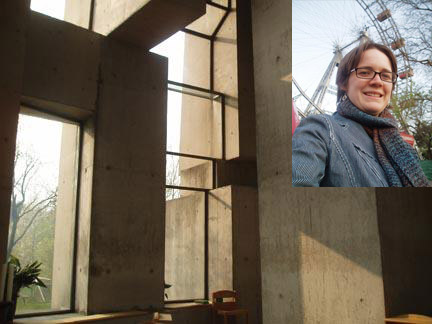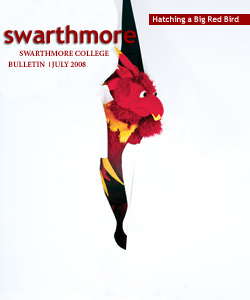Of Power, Paradox, and Prayer

Vienna’s Wotruba Church (pictured) “tells me that when life is a heap of rubble and it seems like everything around is a big scary concrete block trying to fall on your head, you scoop out a little space in that pile and you pray,” wrote Bulletin intern and honors German major Lauren Stokes (inset) who spent a semester abroad in Berlin and Vienna. She reported regularly on her foreign-study experience via the Daily Gazette Web site.
Everyone says Vienna is beautiful, and it’s true, but for the most part it’s the kind of beauty that makes you feel like a little insignificant peasant instead of a human being.
As, I suppose, it’s meant to do. Take a look at the Stephansdom, mostly built by 1511, the main cathedral in Vienna, with allegedly the second-highest church tower in the world.
It’s hard to get a decent picture of Stephansdom because it is much taller than you and also because half of it is currently covered in scaffolding. That said, it does have a beautiful tile roof—basically an ad for the Hapsburg Dynasty. When Antoni Gaudi was asked why he cared so much about the top of his church, he said that the angels were also part of his audience.
Alternatively, head to the suburbs for your religious experience. Two weeks ago, I made the trek out to Otto Wagner’s Kirche am Steinhof, part of the Steinhof Psychiatric Hospital founded in 1902.
Because it’s a church for a psychiatric ward, most of the corners are rounded off, the priests can shut their part of the church off from the “crazy” part, there are emergency exits built into the walls, the pews are especially wide to accommodate “disturbed” patients, and the altarpiece depicts, among others, St. Dymphna, the patron saint of epileptics.
None of this keeps it from being one of the most beautiful buildings I have ever seen.
I wish it stopped there. But Steinhof Psychiatric Hospital, originally a ground-breaking center for treating mental illness, had all of its patients shipped off to gas chambers in 1940. What did the Nazis do with the now empty hospital? They turned it into a laboratory for experiments on sick children, particularly those suffering from tuberculosis and rickets.
Nearly 800 children died here during those years. I left the exhibit on those atrocities absolutely stunned.
Isn’t great art supposed to be uplifting and inspiring? How could people walk by a church that beautiful and still do these things?
Sometimes the gap between how the world is and how it should be hits you, hard, and you sit down on the grounds of a psychiatric hospital and you start crying because what else are you going to do?
The next Sunday, still a bit shaken, always a bit shaken, I set out for what promised to be a very different experience: the Wotruba Church, a super-modern church built in 1976 in the 23rd district of Vienna.
After taking two different subways and one tram, I found myself on a residential street with a 30-minute wait for the next bus, which would take me to a stop about 10 minutes away from the church itself. Not wanting to wait, I decided to take a photo of the area map posted at the bus stop and go for what looked like maybe a 35-minute walk.
One problem with this plan: My digital camera was entirely out of battery. What was I going to do? I’d come too far to turn back. I wrote the directions on my hand and turned to a trick I’d learned in eighth grade. I popped my digital camera battery under my left armpit and began to walk.
When I arrived, the warmed-up battery was just about charged enough to take a picture of the church. What do you think of when you see it? From what I can tell, every German and Austrian in the postwar period was familiar with images of their cities reduced to stones, and the Trümmerfrauen, or rubble-women, who picked through the piles to rebuild. As a German major, that’s what I think of too—an enormous pile of rubble atop a mountain.
Inside, I’m speechless. You wouldn’t think it, but it’s a light-filled space. It’s something of a craggy space, but it’s a beautiful space.
So what did I do? I sat down and cried. But this time–and I’m not using this phrase ironically, not now—this time, I was having a religious experience. Because if Stephansdom is a symbol of imperial power, and Steinhof is a paradox, then the Wotruba Church is a metaphor for how to live.
It tells me that when life is a heap of rubble and it seems like everything around is a big scary concrete block trying to fall on your head, you scoop out a little space in that pile and you pray. And now you’ve turned the pile into something beautiful, and the light comes in through the windows and you’re safe here; it’s all shit outside, but you’re safe, and it’s beautiful …
And now here you are crying again, crying for an hour (an hour!) in a church. It’s a bit like the armpits, really—they may be stinky, but you scoop out a space inside, and now your camera works.
Well, it’s generally more of a struggle, scooping out a space in the rubble of your life, but maybe you get the idea of how good it feels to get through all that to the freedom and the light and the peace in the middle? Because when you get there, you know that if not for the rubble—the rubble, after all, is what makes the space—you wouldn’t have the light and the peace at all.
And to be in a place where they’ve frozen that process, if even for just a moment—a place where the peace is safe inside, where the rubble’s not collapsing in again, where they’ve claimed a space for God or Love or Light or what have you, a space for Good in spite of it all—and now I’m crying again. They warn you on the Web site that Der Besuch dieser Kirche kann Ihr Leben verändern, or “Visiting this church can change your life.”
They’re not trying to sell you anything. But they’re not kidding.
 Email This Page
Email This Page